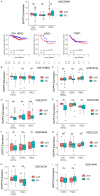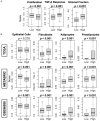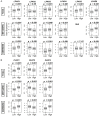Autotaxin production in the human breast cancer tumor microenvironment mitigates tumor progression in early breast cancers
- PMID: 37559999
- PMCID: PMC10408472
Autotaxin production in the human breast cancer tumor microenvironment mitigates tumor progression in early breast cancers
Abstract
Autotaxin (ATX) is a secreted enzyme that produces extracellular lysophosphatidate in physiological wound healing. ATX is overexpressed in many cancers to promote growth, metastasis, and treatment resistance. However, ATX expression is very low in breast cancer cells, and is instead secreted by the tumor microenvironment (TME). Paracrine ATX expression, and its effects on tumor progression, has not been robustly studied in human breast tumors. In this study, ATX expression was analyzed in over 5000 non-metastatic breast cancers from databases TCGA, METABRIC and GSE96058, dichotomized by the median. Gene set enrichment analysis (GSEA) and the xCell algorithm investigated biological functions of ATX and correlation to TME cell populations. TME ATX production was verified by single cell RNA sequencing. The highest ATX expression occurred in endothelial cells and cancer-associated fibroblasts (P<0.0001). High tumor ATX expression correlated to increased adipocyte, fibroblast, and endothelial cell fractions (P<0.01), and GSEA demonstrated enriched immune system, tumor suppressor, pro-survival, stemness, and pro-inflammatory signaling in multiple gene sets. Tumor mutational burden was decreased, Ki67 scores were decreased, tumor infiltrating immune cell populations increased, and immune cytolytic activity scores increased (all P<0.01) for ATX-high tumors. Overall survival trends favored ATX-high tumors (hazard ratios 0.75-0.80). In summary, in human breast cancers, ATX is produced by the TME, and in non-metastatic tumors, high levels correlate with an anti-tumor phenotype. Because pre-clinical models use aggressive pro-metastatic cell lines where ATX-mediated signaling promotes tumorigenesis, further research is required to verify an anti-to-pro-tumor phenotype switch with breast cancer progression and/or treatment resistance.
Keywords: Adipose tissue; adjuvant therapy; cytokines; lysophosphatidic acid; novel therapeutics; tumor progression.
AJCR Copyright © 2023.
Conflict of interest statement
None.
Figures
















Similar articles
-
High EIF4EBP1 expression reflects mTOR pathway activity and cancer cell proliferation and is a biomarker for poor breast cancer prognosis.Am J Cancer Res. 2024 Jan 15;14(1):227-242. doi: 10.62347/MTSD6746. eCollection 2024. Am J Cancer Res. 2024. PMID: 38323277 Free PMC article.
-
Insights into autotaxin- and lysophosphatidate-mediated signaling in the pancreatic ductal adenocarcinoma tumor microenvironment: a survey of pathway gene expression.Am J Cancer Res. 2024 Aug 25;14(8):4004-4027. doi: 10.62347/KQNW1871. eCollection 2024. Am J Cancer Res. 2024. PMID: 39267662 Free PMC article.
-
Decreased Lipid Phosphate Phosphatase 1/3 and Increased Lipid Phosphate Phosphatase 2 Expression in the Human Breast Cancer Tumor Microenvironment Promotes Tumor Progression and Immune System Evasion.Cancers (Basel). 2023 Apr 14;15(8):2299. doi: 10.3390/cancers15082299. Cancers (Basel). 2023. PMID: 37190226 Free PMC article.
-
Role of Adipose Tissue-Derived Autotaxin, Lysophosphatidate Signaling, and Inflammation in the Progression and Treatment of Breast Cancer.Int J Mol Sci. 2020 Aug 18;21(16):5938. doi: 10.3390/ijms21165938. Int J Mol Sci. 2020. PMID: 32824846 Free PMC article. Review.
-
Autotaxin and Lysophosphatidate Signaling: Prime Targets for Mitigating Therapy Resistance in Breast Cancer.World J Oncol. 2024 Feb;15(1):1-13. doi: 10.14740/wjon1762. Epub 2024 Jan 20. World J Oncol. 2024. PMID: 38274724 Free PMC article. Review.
Cited by
-
The Emerging Role of LPA as an Oncometabolite.Cells. 2024 Apr 4;13(7):629. doi: 10.3390/cells13070629. Cells. 2024. PMID: 38607068 Free PMC article. Review.
-
Structure-Based Discovery of MolPort-137: A Novel Autotaxin Inhibitor That Improves Paclitaxel Efficacy.Int J Mol Sci. 2025 Jan 12;26(2):597. doi: 10.3390/ijms26020597. Int J Mol Sci. 2025. PMID: 39859312 Free PMC article.
-
High EIF4EBP1 expression reflects mTOR pathway activity and cancer cell proliferation and is a biomarker for poor breast cancer prognosis.Am J Cancer Res. 2024 Jan 15;14(1):227-242. doi: 10.62347/MTSD6746. eCollection 2024. Am J Cancer Res. 2024. PMID: 38323277 Free PMC article.
-
Insights into autotaxin- and lysophosphatidate-mediated signaling in the pancreatic ductal adenocarcinoma tumor microenvironment: a survey of pathway gene expression.Am J Cancer Res. 2024 Aug 25;14(8):4004-4027. doi: 10.62347/KQNW1871. eCollection 2024. Am J Cancer Res. 2024. PMID: 39267662 Free PMC article.
-
An anoikis-related lncRNA signature may predict the prognosis, immune infiltration, and drug sensitivity in esophageal cancer.Heliyon. 2024 May 14;10(10):e31202. doi: 10.1016/j.heliyon.2024.e31202. eCollection 2024 May 30. Heliyon. 2024. PMID: 38803953 Free PMC article.
References
-
- Siegel RL, Miller KD, Fuchs HE, Jemal A. Cancer statistics, 2022. CA Cancer J Clin. 2022;72:7–33. - PubMed
-
- Centers for Disease Control and Prevention. U.S. Cancer Statistics Female Breast Cancer Stat Bite. US Department of Health and Human Services. 2022
Grants and funding
LinkOut - more resources
Full Text Sources
